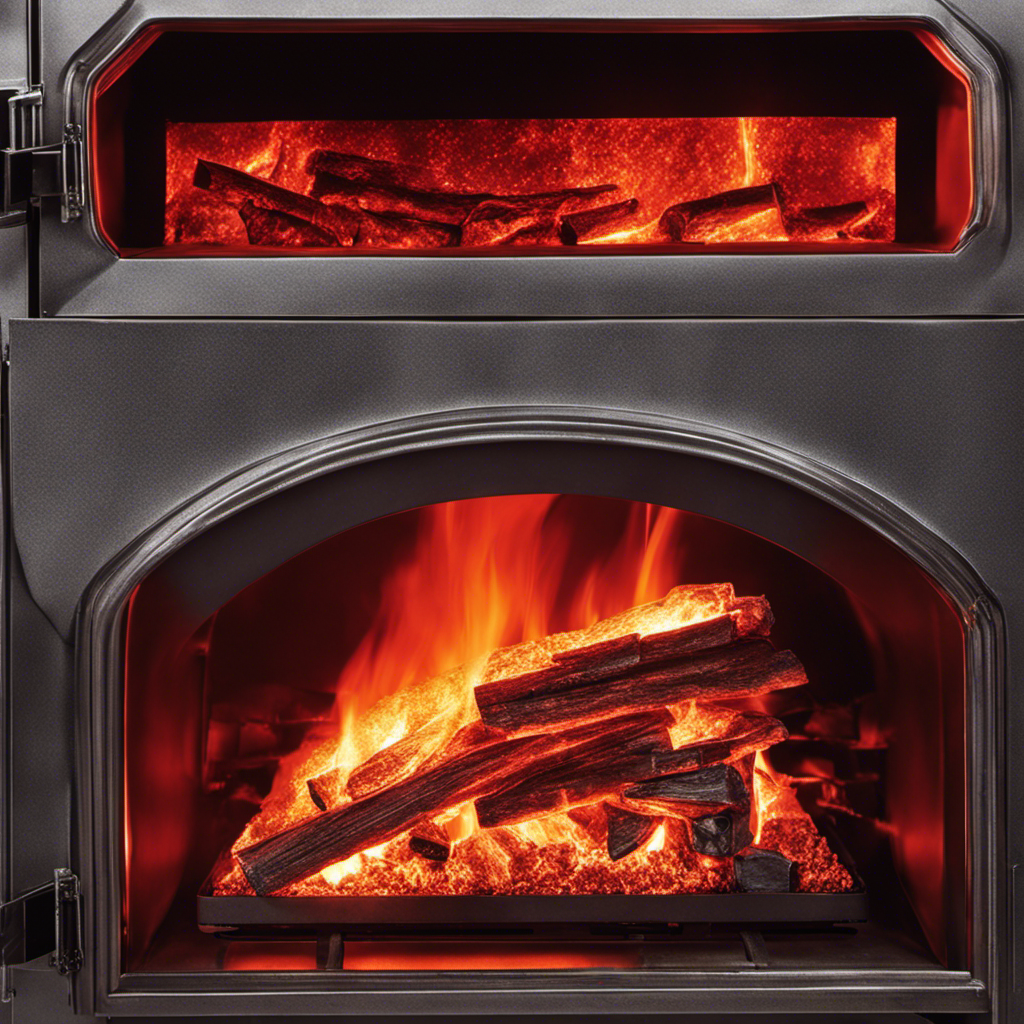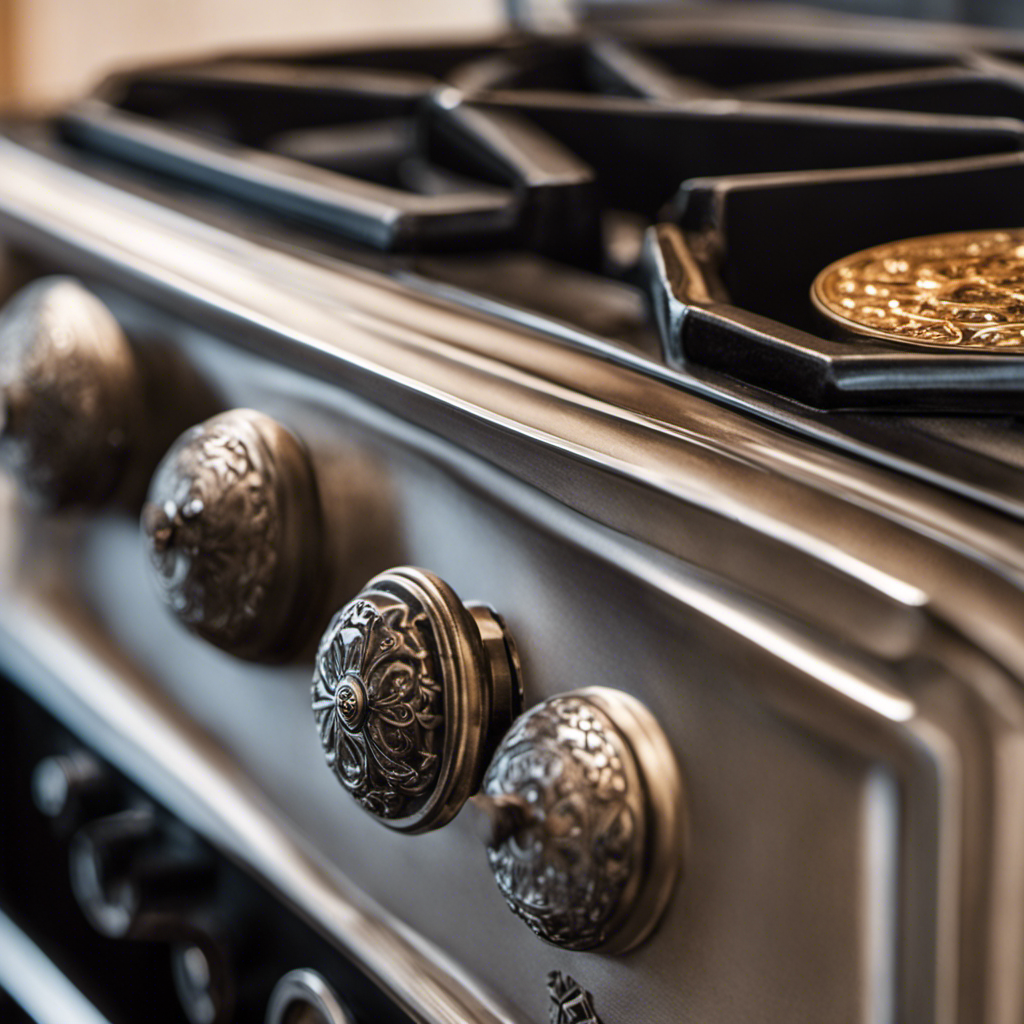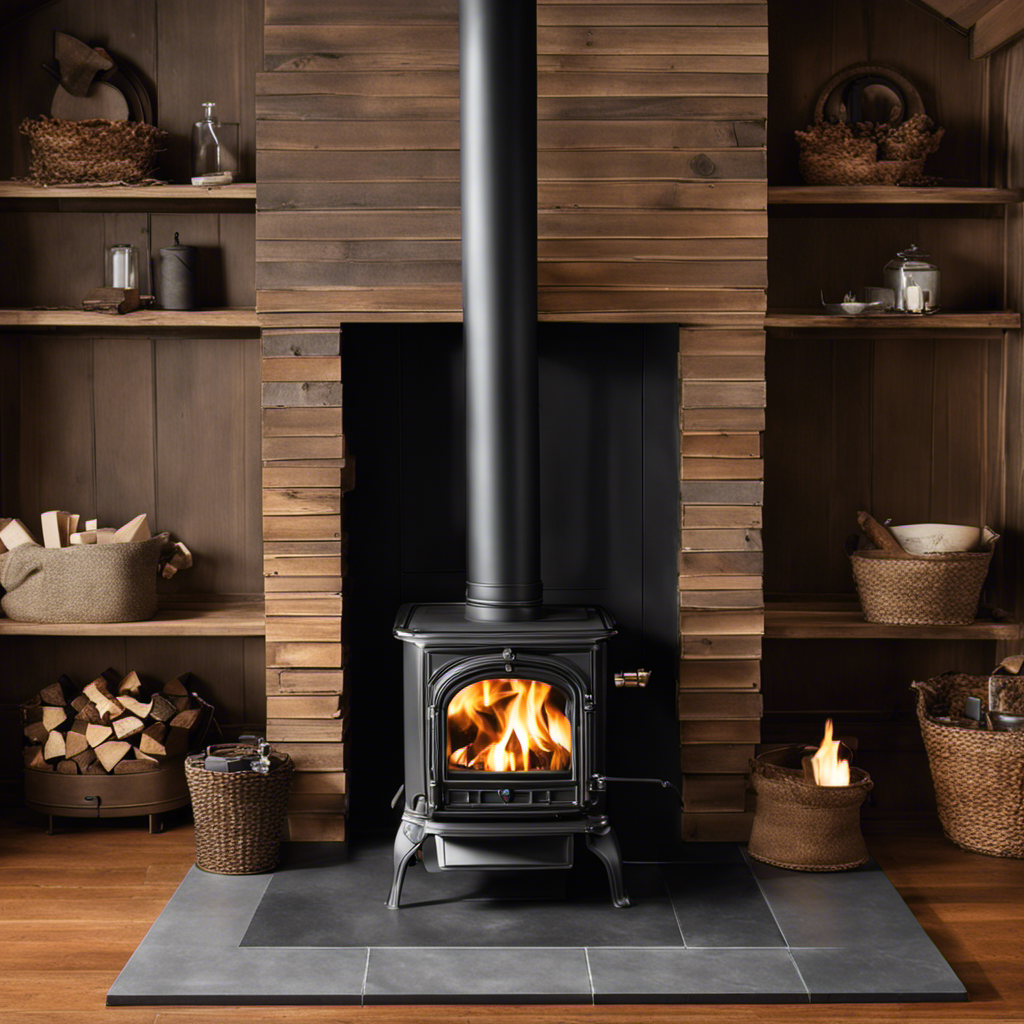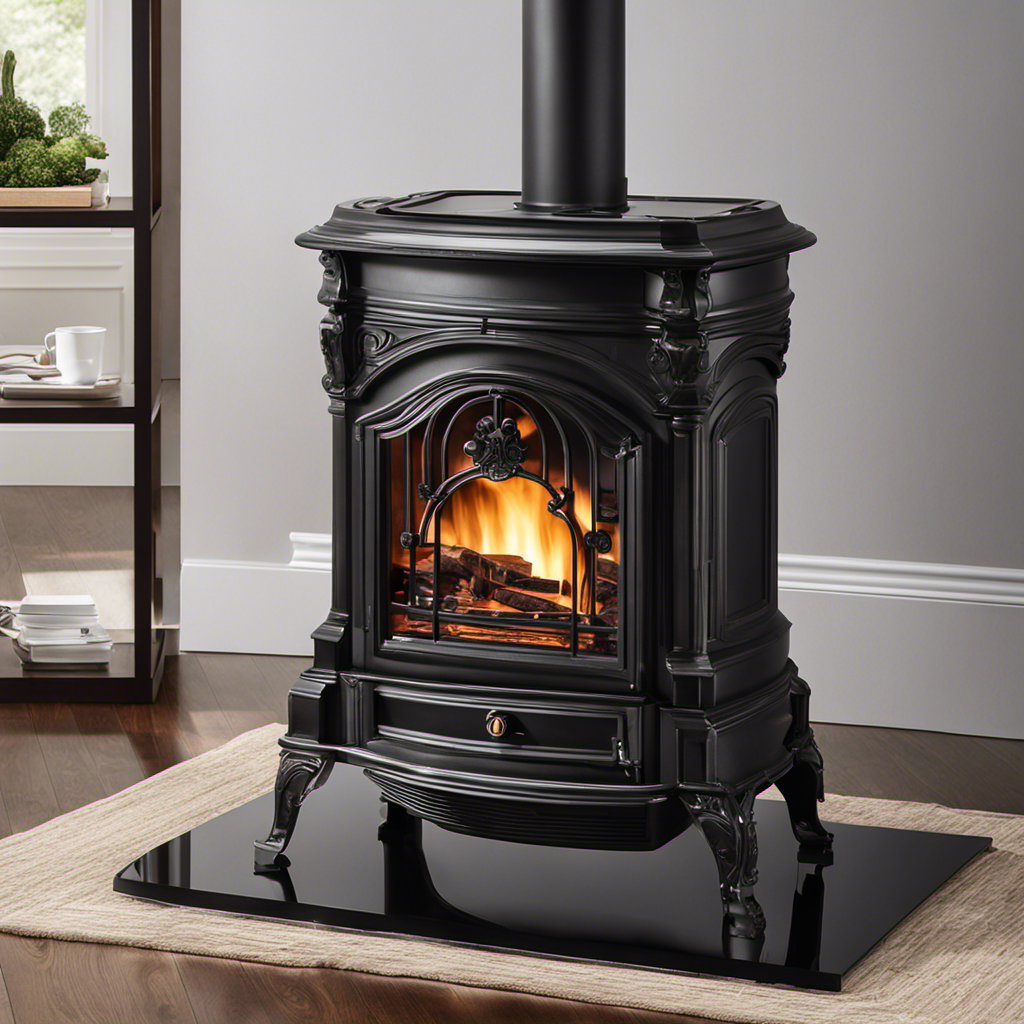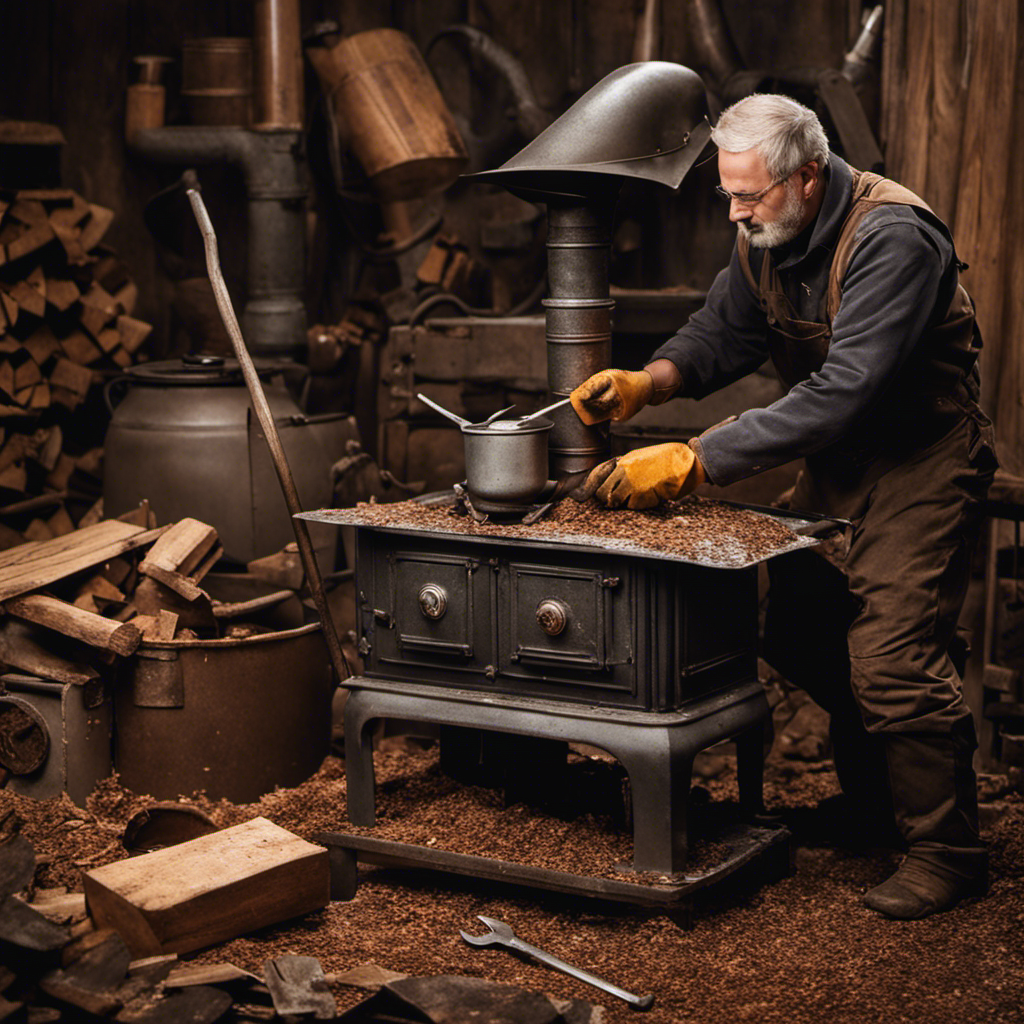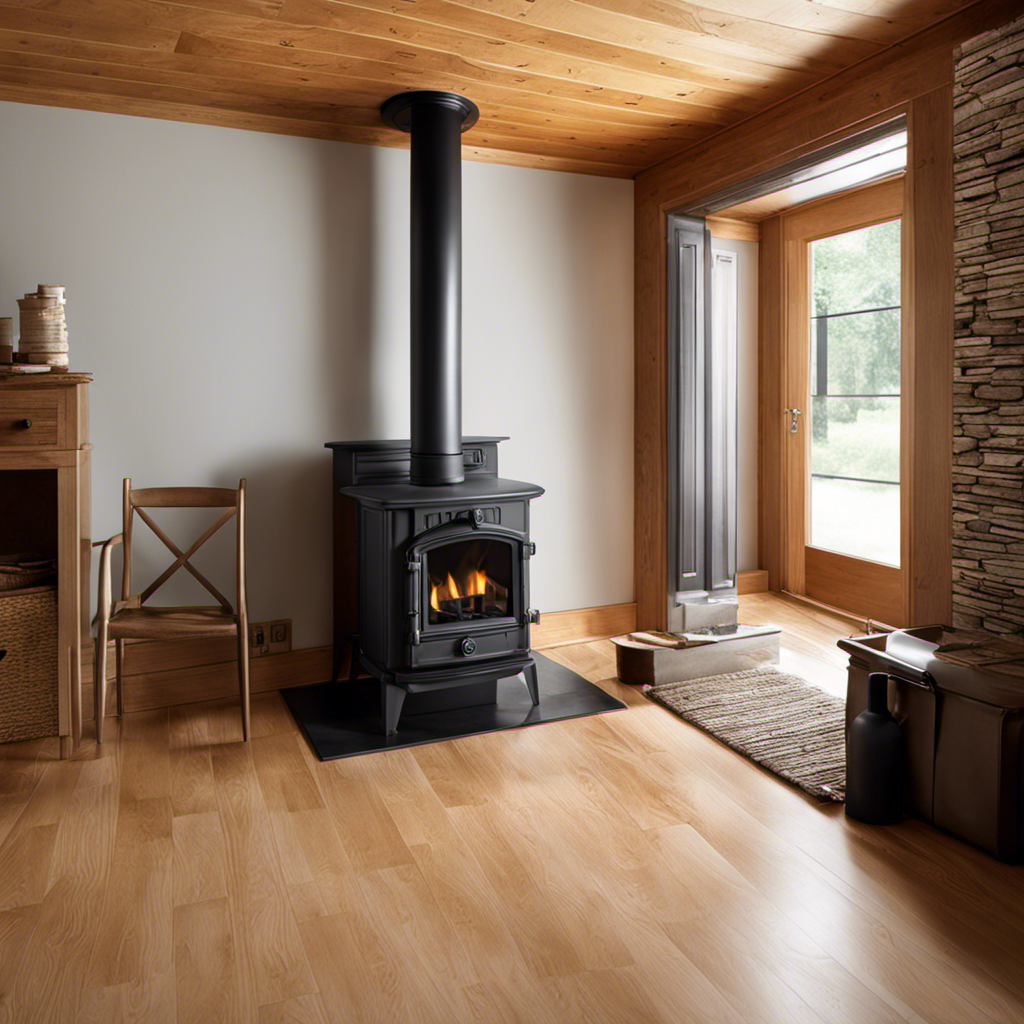Pellet Stoves
Beware: Carbon Monoxide Dangers Lurk in Pellet Stoves
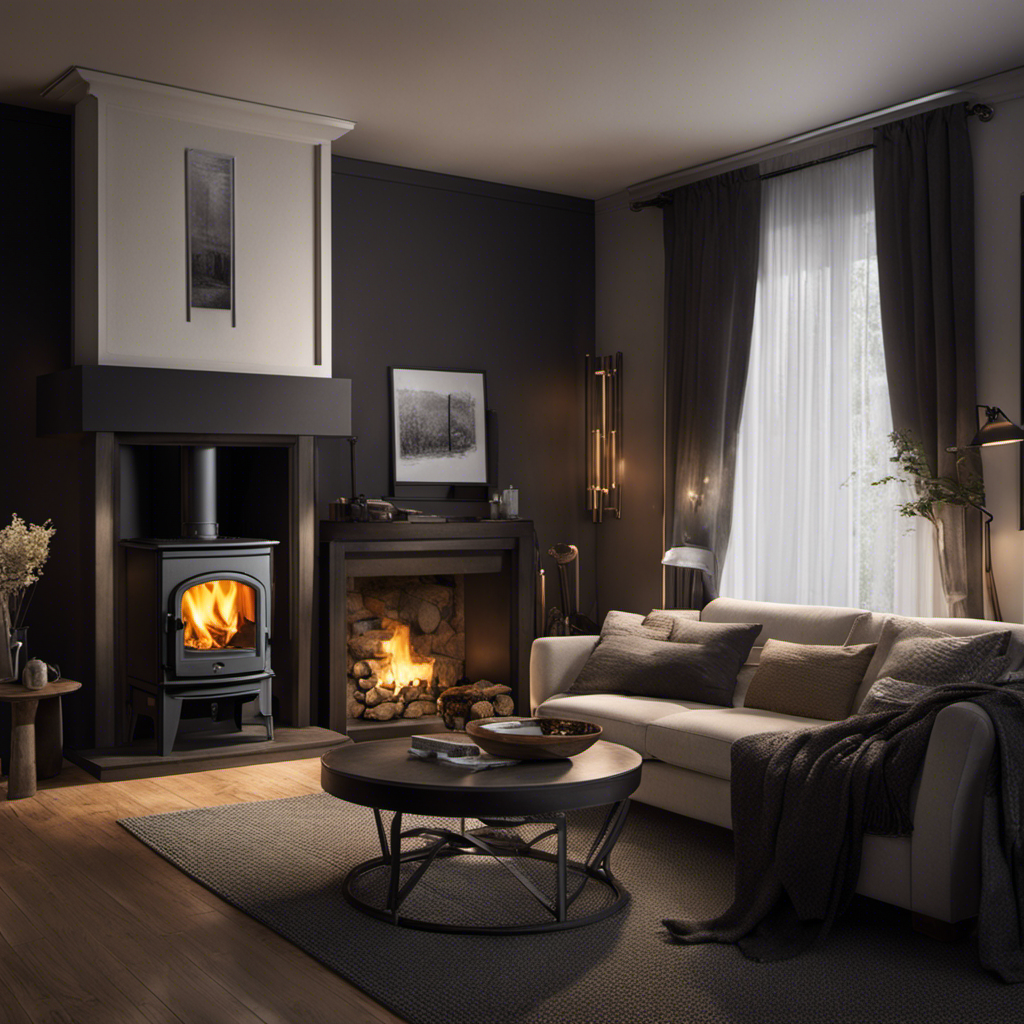
As conscientious homeowners, it’s vital to be mindful of the dangers associated with carbon monoxide exposure resulting from utilizing pellet stoves. Even though these heating systems are known for their efficiency and eco-friendly nature, they can emit an odorless and colorless gas, which presents risks that could result in severe harm or fatalities if inhaled.
By understanding the factors that contribute to carbon monoxide production in pellet stoves and taking preventive measures such as regular maintenance and the installation of carbon monoxide detectors, we can ensure the safety of ourselves and our loved ones.
Key Takeaways
- Pellet stoves burn wood pellets and can produce carbon monoxide.
- Carbon monoxide is a colorless, odorless gas that can be harmful and even deadly.
- The risk of carbon monoxide poisoning from pellet stoves is low but can be increased by factors such as incomplete burning or blockages in the flue.
- To prevent carbon monoxide poisoning, it is important to have regular maintenance, proper venting, and a working carbon monoxide detector near the pellet stove.
The Silent Threat: Carbon Monoxide and Pellet Stoves
We need to be aware of the silent threat of carbon monoxide when using pellet stoves.
Carbon monoxide is a colorless, odorless gas that can be produced by any combustion appliance, including pellet stoves. Inhaling carbon monoxide can have serious health consequences, so it’s crucial to have a working carbon monoxide detector in your home.
Additionally, certain factors can increase the risk of carbon monoxide poisoning from pellet stoves, such as incomplete burning of pellets and blockages in the flue or vent pipe. To prevent carbon monoxide production, regular maintenance and proper venting are essential.
It’s recommended to have your pellet stove serviced annually by a qualified technician and ensure proper venting. By taking these precautions and using a carbon monoxide detector, you can reduce the risk of carbon monoxide poisoning when using pellet stoves.
Understanding the Risks: Carbon Monoxide Poisoning and Pellet Stoves
As homeowners, it’s important for us to understand the risks associated with carbon monoxide poisoning and the use of pellet stoves. Carbon monoxide is a colorless, odorless gas that can be produced by any combustion appliance, including pellet stoves. Inhaling carbon monoxide can have severe effects, ranging from headaches and dizziness to nausea and even death. Therefore, it’s crucial to have a working carbon monoxide detector in our homes.
Although the risk of carbon monoxide poisoning from pellet stoves is generally low, certain circumstances can increase the risk. Factors such as incomplete burning of pellets and blockages in the flue or vent pipe can contribute to carbon monoxide production. To mitigate these risks, regular maintenance and cleaning of pellet stoves are of utmost importance. Additionally, ensuring proper venting and using dry, seasoned wood pellets can help prevent carbon monoxide poisoning.
Factors Affecting Carbon Monoxide Production in Pellet Stoves
Improper burning of fuel and blockages in the venting system are key factors that contribute to the production of carbon monoxide in pellet stoves. When fuel isn’t burned correctly, carbon monoxide is produced. Dirty or malfunctioning pellet stoves can also release this harmful gas. It’s essential to regularly clean and maintain your pellet stove to prevent carbon monoxide production.
Proper venting is crucial as well, as blockages in the venting system can lead to the buildup of carbon monoxide. These factors can have a significant impact on indoor air quality, as inhaling carbon monoxide can cause serious health issues.
The Importance of Proper Venting in Preventing Carbon Monoxide Poisoning
When the venting system isn’t properly installed or maintained, it can increase the risk of carbon monoxide poisoning. Proper venting is crucial in preventing carbon monoxide from building up in your home.
Regular maintenance is essential to ensure that the venting system is functioning correctly and free from blockages. Blockages in the flue or vent pipe can restrict the flow of exhaust gases, causing them to back up into your living space. This can lead to the accumulation of carbon monoxide, which is extremely dangerous.
Maintenance Matters: Keeping Your Pellet Stove Safe From Carbon Monoxide
Regular maintenance is essential to ensure the safety of our pellet stove and prevent the risk of carbon monoxide. Neglecting maintenance can lead to a buildup of soot and debris, which can block the airflow and cause incomplete combustion. Here are three important cleaning techniques for pellet stoves:
-
Clean the burn pot: Over time, ash and residue can accumulate in the burn pot, affecting the stove’s efficiency. Regularly remove the burn pot and clean it thoroughly using a brush or vacuum.
-
Clean the venting system: The venting system plays a crucial role in safely removing combustion gases. Inspect the vent pipe for any blockages or obstructions, and clean it if necessary. Ensure that the venting system is properly sealed and free from leaks.
-
Clean the glass door: The glass door of the pellet stove can become dirty and affect the view of the fire. Use a non-abrasive glass cleaner and a soft cloth to clean the glass regularly, allowing for a clear view and enhancing the ambiance of your pellet stove.
The Role of Dirty or Malfunctioning Pellet Stoves in Carbon Monoxide Dangers
Dirty or malfunctioning pellet stoves can pose a significant risk of carbon monoxide exposure. When a pellet stove is dirty or not functioning properly, it can lead to incomplete burning of the fuel, which increases the production of carbon monoxide.
A dirty stove can have buildup in the burn pot or on the heat exchanger, which can hinder the combustion process and result in the release of carbon monoxide. Similarly, a malfunctioning stove may have issues with the combustion fan, auger, or venting system, which can also lead to the production of carbon monoxide.
Regular maintenance and cleaning of pellet stoves are essential to ensure proper functioning and reduce the risk of carbon monoxide poisoning. It’s crucial to address any issues with dirty or malfunctioning pellet stoves promptly to protect the safety of your home and family.
Dry and Seasoned: Choosing the Right Wood Pellets to Avoid Carbon Monoxide Risks
Choosing dry and seasoned wood pellets is crucial for reducing the risk of carbon monoxide exposure from pellet stoves. When it comes to selecting the right fuel for your pellet stove, here are three important tips to keep in mind:
-
Look for dry wood pellets: Moisture content in wood pellets should be below 10%. Wet or damp pellets can result in incomplete combustion, leading to increased carbon monoxide production.
-
Opt for seasoned wood pellets: Seasoned pellets have been properly dried and aged, ensuring a higher heat output and cleaner burn. This reduces the likelihood of carbon monoxide emissions.
-
Check for quality certifications: Look for wood pellets that have been certified by reputable organizations, such as the Pellet Fuels Institute (PFI) or the Sustainable Forestry Initiative (SFI). These certifications guarantee that the pellets meet specific quality standards.
Annual Servicing: Protecting Your Home From Carbon Monoxide With a Qualified Technician
To ensure the safety of our home, we should have a qualified technician service our pellet stove annually. Annual servicing benefits are numerous when it comes to protecting our home from carbon monoxide dangers.
A qualified technician possesses the necessary qualifications and expertise to thoroughly inspect and clean our pellet stove. They’ll check for any potential issues that could lead to the production of carbon monoxide, such as blockages in the flue or vent pipe.
By conducting regular maintenance, a qualified technician can ensure that our pellet stove is functioning properly and burning fuel efficiently. This reduces the risk of incomplete burning, which can produce carbon monoxide.
Additionally, a qualified technician can provide guidance on proper venting and the use of dry, seasoned wood pellets.
The Crucial Role of Carbon Monoxide Detectors in Pellet Stove Safety
Having a properly functioning carbon monoxide detector near our pellet stove is crucial for ensuring the safety of our home and family. Carbon monoxide is a silent killer, and understanding the risks it poses in pellet stoves is essential.
Here are three important points to consider:
-
Early Detection: A carbon monoxide detector acts as an early warning system, alerting us to the presence of this deadly gas. It can detect even trace amounts of carbon monoxide in the air, allowing us to take immediate action.
-
Peace of Mind: Having a carbon monoxide detector near our pellet stove provides peace of mind. We can rest assured knowing that if any carbon monoxide is being produced, we’ll be alerted promptly, allowing us to evacuate and address the issue before it becomes life-threatening.
-
Prevention: The role of a carbon monoxide detector isn’t just about detection, but also prevention. By having a detector in place, we’re more likely to prioritize regular maintenance, cleaning, and proper venting of our pellet stove. This proactive approach significantly reduces the risk of carbon monoxide production and poisoning.
Best Practices: Reducing the Risk of Carbon Monoxide Poisoning From Pellet Stoves
Reducing the risk of carbon monoxide poisoning from pellet stoves requires regular maintenance, proper venting, and using dry, seasoned wood pellets. To minimize the risk, it’s crucial to adhere to these best practices.
Firstly, regular maintenance is essential for ensuring the proper functioning of the stove. This includes cleaning the stove and inspecting it for any blockages or malfunctions.
Secondly, proper venting is crucial for the safe operation of the pellet stove. Ensure that the vent pipe is clear of any obstructions and that it’s properly installed according to the manufacturer’s guidelines.
Lastly, using dry, seasoned wood pellets is important as they burn more efficiently and produce less carbon monoxide.
Expert Tips for Ensuring Proper Venting in Your Pellet Stove Setup
When it comes to ensuring proper venting in your pellet stove setup, there are a few expert tips that can help you avoid any potential issues. Here are three key tips to keep in mind:
-
Regular maintenance: It’s important to schedule regular venting maintenance for your pellet stove. This includes inspecting and cleaning the vent pipe and chimney to ensure they’re free from blockages and debris. A clear and clean venting system will allow for proper airflow and prevent any potential carbon monoxide buildup.
-
Troubleshooting issues: If you notice any issues with your pellet stove’s venting, such as poor draft or excessive smoke, it’s important to troubleshoot and address them promptly. This may involve checking for obstructions in the vent pipe, adjusting the damper, or ensuring the venting system is properly sealed. Ignoring these issues can lead to inefficient burning and increased risk of carbon monoxide production.
-
Seek professional help: If you’re uncertain about the venting setup or encounter persistent problems, it’s best to consult a professional technician. They have the expertise to assess your pellet stove setup, identify any venting maintenance requirements or issues, and provide the necessary solutions to ensure safe and efficient operation.
Stay Alert: Signs and Symptoms of Carbon Monoxide Poisoning From Pellet Stoves
We need to be aware of the signs and symptoms of carbon monoxide poisoning from pellet stoves to ensure our safety. Carbon monoxide is a silent killer, and being able to recognize the warning signs can save lives. The health effects of carbon monoxide poisoning can range from mild symptoms like headaches and dizziness to more severe symptoms like nausea and even death. To help you stay informed, here are some common signs and symptoms of carbon monoxide poisoning:
| Warning Signs | Health Effects |
|---|---|
| Headaches | Dizziness |
| Nausea | Confusion |
| Shortness of breath | Loss of consciousness |
| Fatigue | Death |
If you or anyone in your household experience these symptoms and suspect carbon monoxide poisoning, it is essential to seek fresh air immediately and call emergency services. Remember, prevention is key, so make sure to have a working carbon monoxide detector near your pellet stove and have it serviced regularly by a qualified technician. Stay alert and prioritize your safety.
Are There Any Safety Measures to Prevent Carbon Monoxide Dangers in Pellet Stoves?
Pellet stoves are a great alternative for heating, but carbon monoxide dangers are a real concern. To prevent this, make sure to install a carbon monoxide detector nearby and have regular maintenance checks. Understanding the aromatic secrets of pellet stoves shouldn’t put your safety at risk.
Can a Stinky Pellet Stove be a Sign of Carbon Monoxide Danger?
If you notice strange smells coming from your pellet stove, it’s important to address the issue promptly. Troubleshooting pellet stove odors can help identify potential problems, including carbon monoxide danger. Don’t ignore a stinky pellet stove – it could be a sign of a serious issue that needs attention.
Frequently Asked Questions
What Are the Signs and Symptoms of Carbon Monoxide Poisoning From Pellet Stoves?
The signs and symptoms of carbon monoxide poisoning from pellet stoves can include headaches, dizziness, nausea, and even death.
It’s crucial to have a working carbon monoxide detector in your home to detect any potential issues.
Prevention measures such as annual servicing by a qualified technician, proper venting, and using dry, seasoned wood pellets can help reduce the health risks associated with carbon monoxide poisoning from pellet stoves.
How Often Should a Carbon Monoxide Detector Be Replaced?
When it comes to carbon monoxide detectors, it’s important to know their lifespan and when to replace them.
The lifespan of a carbon monoxide detector is typically around 5-7 years. However, it’s always a good idea to check the manufacturer’s recommendations for your specific model.
Additionally, if your carbon monoxide detector starts giving false alarms or becomes unresponsive, it’s time to replace it.
Can Carbon Monoxide Be Produced Even if the Pellet Stove Is Properly Vented?
Yes, carbon monoxide can still be produced even if the pellet stove is properly vented.
Understanding the dangers of carbon monoxide in pellet stoves is crucial.
While the risk of carbon monoxide poisoning from pellet stoves is generally low, certain factors can increase the risk, such as incomplete burning of pellets or blockages in the flue or vent pipe.
Regular maintenance, proper venting, and the use of a carbon monoxide detector are important in preventing carbon monoxide risks in properly vented pellet stoves.
Are There Any Specific Maintenance Tasks That Homeowners Can Do to Prevent Carbon Monoxide Production?
To prevent carbon monoxide production in pellet stoves, homeowners can take preventative measures through regular inspections and maintenance tasks.
These tasks include ensuring proper venting, cleaning the stove and flue, and checking for any blockages.
By having a qualified technician service the pellet stove annually, potential issues can be identified and addressed.
These proactive steps can help homeowners reduce the risk of carbon monoxide poisoning and ensure the safe operation of their pellet stoves.
Can Carbon Monoxide Detectors Detect Other Gases or Only Carbon Monoxide?
Carbon monoxide detectors are specifically designed to detect carbon monoxide gas. They’re highly accurate in detecting this gas, which is colorless and odorless. While carbon monoxide detectors aren’t designed to detect other gases, they play a crucial role in ensuring the safety of your home.
Conclusion
In conclusion, when it comes to pellet stoves, the saying ‘better safe than sorry’ rings true. Carbon monoxide poses a serious threat, but by taking proactive measures such as regular maintenance, proper venting, and the use of carbon monoxide detectors, we can enjoy the benefits of pellet stoves while keeping ourselves and our loved ones safe.
Remember, prevention is key when it comes to protecting against the silent dangers of carbon monoxide. Stay informed, stay vigilant, and stay safe.
Pellet Stoves
How Can You Tell the Quality of Wood Pellet Fuel

Looking at the pile of wood pellets in front of me, I can’t help but wonder: what criteria should I use to evaluate the quality of this fuel? With numerous choices on the market, it is essential to understand the key features to consider.
In this article, I will guide you through the process of assessing wood pellet fuel quality. From the physical appearance to the ash and moisture content, heat output, and pellet durability, we will leave no stone unturned.
So, let’s dive in and unravel the secrets to identifying top-notch wood pellet fuel.
Key Takeaways
- Dust-free and uniform appearance indicate high quality wood pellet fuel.
- Low ash content leads to efficient burning, higher heat output, and reduced environmental impact.
- Proper moisture content of 6-8% is essential for optimal burning efficiency.
- High-quality pellets have high durability, resist breaking and crumbling, and have low carbon emissions during combustion.
Physical Appearance
When assessing the quality of wood pellet fuel, you should examine its physical appearance to ensure it is free from dust and has a uniform shape and color. Color variations can indicate inconsistencies in the manufacturing process, which may affect the fuel’s combustion efficiency.
A thorough texture analysis is also crucial. The pellets should have a dense and compact structure, without any visible cracks or breaks. This ensures that the pellets will burn efficiently and produce consistent heat output. Additionally, the texture should be smooth and uniform, without any rough edges or irregularities.
By carefully inspecting the physical appearance of the wood pellet fuel, you can determine its overall quality and performance.
Now, let’s move on to discussing the ash content and its importance in assessing the quality of wood pellet fuel.
Ash Content
To determine the ash content of wood pellet fuel, check the amount of residue left behind after combustion. The ash content is an important factor in evaluating the quality of wood pellets because it affects combustion efficiency and environmental impact. Here are three key points to consider:
-
Combustion efficiency: High-quality wood pellets have low ash content, which means less residue is produced during combustion. This leads to more efficient burning and higher heat output.
-
Environmental impact: Wood pellets with low ash content have a lower environmental impact. They produce less particulate matter and emissions, reducing air pollution and contributing to cleaner air quality.
-
Ash disposal: Low ash content also means less ash residue to dispose of after combustion. This simplifies the clean-up process and reduces the frequency of ash removal, making wood pellet fuel a convenient and low-maintenance option.
Considering the ash content is an essential step in assessing the quality of wood pellet fuel. The next aspect to examine is the moisture content.
Moisture Content
Check the moisture content of your wood pellets to ensure optimal burning efficiency and performance. Proper storage of wood pellets is essential to maintaining their moisture content. Wood pellets should be stored in a dry and well-ventilated area to prevent moisture absorption.
High moisture content in wood pellets can lead to poor combustion, reduced heat output, and increased emissions. Moisture content is typically measured using a moisture meter, which provides an accurate reading of the amount of water present in the pellets. It is recommended to aim for a moisture content of around 6-8% for optimal burning efficiency.
Heat Output
Keep in mind that high moisture content in your wood pellets can result in reduced heat output and inefficient burning. To ensure optimal heat output and combustion efficiency, here are four factors to consider when evaluating the quality of wood pellet fuel:
-
Low Moisture Content: Look for pellets with a moisture content below 10%. High moisture levels can lead to incomplete combustion and decreased heat output.
-
Density: The density of the pellets affects their burn time and heat output. Higher density pellets provide longer burn times and more consistent heat.
-
Ash Content: Lower ash content means less residue and more efficient burning. Look for pellets with ash content below 1%.
-
Carbon Emissions: High-quality pellets produce lower carbon emissions, making them more environmentally friendly and reducing air pollution.
Now, let’s move on to pellet durability, which is another important aspect to consider when assessing wood pellet fuel quality.
Pellet Durability
When evaluating the durability of pellets, it’s important to consider their resistance to breaking and crumbling. High-quality wood pellet fuel should be able to withstand handling and transportation without easily breaking apart. This can be determined by observing the pellets for any signs of damage or crumbling.
Additionally, the storage requirements of wood pellets should be taken into consideration. Proper storage conditions, such as keeping the pellets in a dry and ventilated area, can help maintain their durability over time.
Furthermore, it is crucial to consider the environmental impact of wood pellets. Sustainable sourcing and production methods, as well as low emissions during combustion, are indicators of environmentally friendly pellets.
What are the indicators of high-quality wood pellet fuel?
High quality wood pellet characteristics include low moisture content, uniform size and shape, low ash content, and high heating value. These indicators indicate the fuel’s efficiency, cleanliness, and energy output. When buying wood pellet fuel, be sure to look for these characteristics to ensure a high-quality product.
What Are the Indicators of Quality Wood Pellet Fuel?
The indicators of telling high quality wood pellets include a low moisture content, consistent pellet length and density, minimal ash production, and a clean, light-colored appearance. These factors help ensure efficient, clean-burning fuel for your pellet stove or boiler, making for a more environmentally friendly heat source.
Frequently Asked Questions
How Long Can Wood Pellet Fuel Be Stored Before It Starts to Degrade in Quality?
Wood pellet fuel can degrade in quality if stored for too long. The storage time before degradation varies, but generally, it is recommended to use the fuel within one year to ensure optimal quality and performance.
What Is the Average Cost of Wood Pellet Fuel Compared to Other Types of Fuels?
The average cost of wood pellet fuel compared to other fuels can vary depending on factors such as location, demand, and availability. It’s important to consider these factors when determining the cost of wood pellet fuel.
Are There Any Specific Storage Requirements for Wood Pellet Fuel to Maintain Its Quality?
To maintain the quality of wood pellet fuel, proper storage requirements are crucial. Factors such as moisture content, temperature, and exposure to sunlight can impact its quality.
Can Wood Pellet Fuel Be Used in All Types of Wood Pellet Stoves and Boilers?
Wood pellet fuel can be used in different types of wood pellet stoves and boilers. However, it’s important to check the compatibility of the fuel with your specific appliance to ensure optimal performance.
Are There Any Environmental Benefits of Using Wood Pellet Fuel Compared to Other Fossil Fuels?
There are several ways to determine the quality of wood pellet fuel, such as inspecting for low ash content and uniform size. These factors contribute to its environmental benefits and make it a renewable energy source.
Conclusion
In conclusion, when it comes to determining the quality of wood pellet fuel, it is crucial to consider various factors. By carefully examining the physical appearance, ash content, moisture content, heat output, and pellet durability, one can gain valuable insights into the overall quality of the pellets.
This evaluation process is akin to peering through a magnifying glass, uncovering hidden details and ensuring that only the best fuel is chosen for optimal performance. Just like a discerning detective, it is important to investigate every aspect to guarantee a superior wood pellet fuel experience.
Pellet Stoves
How Are Wood Pellets Made for Wood Pellet Bbqs
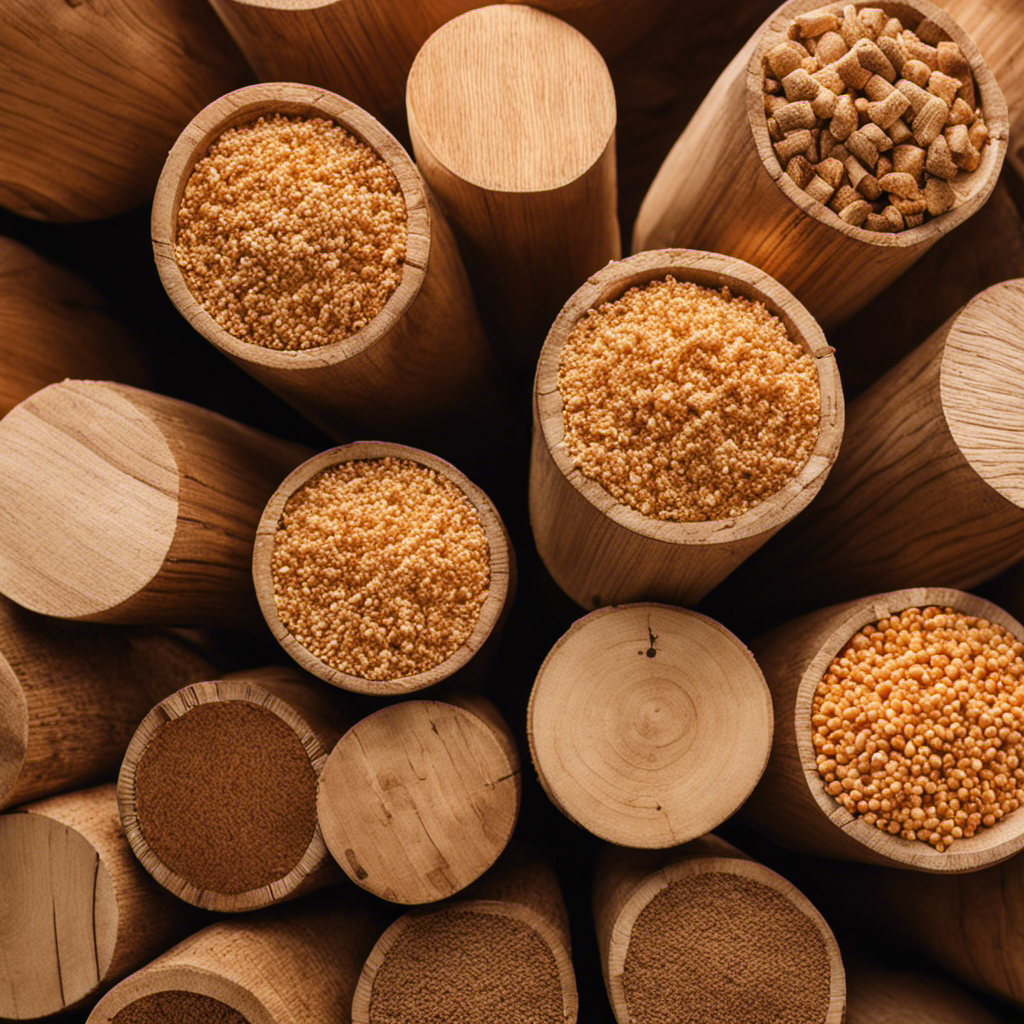
Standing in front of my wood pellet BBQ, the air is filled with the delightful smell of smoky scents.
But have you ever wondered how these wood pellets are made? Join me on a journey through the intricate process of transforming wood into BBQ-ready pellets.
From harvesting and processing the wood to the crucial role of heat and pressure, we’ll explore the key ingredients and quality control measures that ensure the perfect pellet for your grilling adventures.
Get ready to uncover the secrets behind the magic of wood pellet BBQs.
Key Takeaways
- Wood pellets provide consistent and flavorful fuel for wood pellet BBQs.
- The tree selection and harvesting process is crucial for high-quality wood pellet production.
- Specialized wood chipping and drying techniques are used to prepare the raw material for pellet manufacturing.
- The pellet manufacturing process involves compressing and extruding dried wood fibers into high-quality pellets.
The Importance of Wood Pellets in Wood Pellet Bbqs
Wood pellets are essential for wood pellet BBQs because they provide a consistent and flavorful fuel source. The importance of wood pellet flavor cannot be overstated when it comes to achieving that authentic smoky taste in your BBQ dishes.
Unlike other fuel sources, such as charcoal or gas, wood pellets infuse a rich and distinct flavor into the food. This is because wood pellets are made from compressed sawdust, which retains the natural oils and aromas of the wood.
The benefits of using wood pellets in BBQ cooking go beyond just flavor. Wood pellets burn efficiently, producing a steady and consistent heat that is ideal for slow cooking and smoking. Additionally, wood pellets are environmentally friendly, as they are made from renewable resources and emit fewer pollutants compared to other fuel sources.
Transitioning into the subsequent section about the steps to harvesting and processing wood for pellet production, it is important to understand the meticulous process involved in creating these high-quality wood pellets.
Steps to Harvesting and Processing Wood for Pellet Production
When it comes to producing high-quality wood pellets, the tree selection process plays a crucial role. It involves carefully choosing the right type of trees that are suitable for pellet production, considering factors such as wood density, moisture content, and heat value.
Additionally, wood chipping techniques are essential in creating uniform and consistent wood chips that can be efficiently processed into pellets.
Lastly, understanding the pellet manufacturing methods is essential, as it involves transforming the wood chips into compact and dense pellets through processes like drying, grinding, and compressing.
Tree Selection Process
To ensure the quality of your wood pellets for your BBQ, you’ll want to carefully select the trees that are used in the manufacturing process. Here are three important considerations when choosing trees for wood pellet production:
-
Tree planting techniques: It is crucial to use appropriate planting techniques to ensure the healthy growth of trees. This includes selecting the right tree species based on climate and soil conditions, proper spacing between trees, and adequate watering and fertilization.
-
Environmental impact assessment: Before harvesting trees for pellet production, an environmental impact assessment should be conducted. This assessment evaluates the potential effects on the ecosystem, including air and water quality, wildlife habitat, and soil erosion. It helps ensure sustainable practices are followed and minimize any negative impacts.
-
Tree selection criteria: When selecting trees, certain characteristics are preferred. Trees that have reached optimal maturity and have a high density of cellulose and lignin are ideal for producing high-quality wood pellets. Additionally, trees that are straight and have minimal branches are easier to process into pellets.
By carefully considering these factors, you can ensure that the trees used in the manufacturing process result in top-notch wood pellets for your BBQ.
In the next section, we will delve into the wood chipping techniques used to prepare the selected trees for pellet production.
Wood Chipping Techniques
By using specialized equipment, the selected trees are chipped into small pieces for easier processing into high-quality wood pellets.
Wood chip suppliers play a crucial role in providing the necessary raw material for pellet production. These suppliers carefully select trees that are suitable for chipping, ensuring that they are free from diseases, rot, or other contaminants.
Once the trees have been harvested, they are transported to the wood chip storage area, where they are stored in large piles or silos. These storage facilities protect the wood chips from moisture and maintain their quality.
The wood chips are then fed into the chipping machine, which uses sharp blades to cut them into smaller, uniform pieces. This process increases the surface area of the chips, making them easier to dry and compress.
The chipped wood is now ready for further processing in the pellet manufacturing methods, where it will be transformed into high-quality wood pellets.
Pellet Manufacturing Methods
Once the wood chips are chipped into small pieces, they can be processed into high-quality wood pellets using specialized methods.
Wood pellets are known for their consistent size, high energy density, and low moisture content, making them ideal for use as fuel in wood pellet BBQs.
To manufacture wood pellets, the chipped wood is first dried to reduce its moisture content. Then, it is fed into a pellet mill, where it undergoes compression and extrusion to form cylindrical pellets.
The pellet production equipment typically includes a hammer mill, dryer, pellet mill, and cooler. These machines work together to transform the chipped wood into uniform pellets with specific properties.
The process of turning wood into pellets for BBQ use requires careful attention to detail and adherence to strict quality control standards.
The Process of Turning Wood Into Pellets for Bbq Use
When it comes to wood pellet production for BBQ use, there are several key points to consider.
First, understanding the process of wood pellet production is crucial in order to appreciate the quality and efficiency of the pellets.
Second, BBQ pellet manufacturing involves specific considerations to ensure the pellets are suitable for use in barbecues.
Lastly, the pellet-making process itself involves several steps, including grinding, drying, and compressing the wood fibers into pellets.
Wood Pellet Production?
To understand how wood pellets are made for wood pellet BBQs, you can start by learning about the process of wood pellet production. This process involves several steps that ensure the high quality of the pellets used for BBQs. Here are some key points to consider:
- Raw Materials: Wood pellets are typically made from sawdust or other wood waste materials obtained from sustainable sources.
- Grinding: The raw materials are first ground into a fine powder to increase their surface area and facilitate the subsequent steps.
- Drying: The powdered wood is then dried to reduce its moisture content, making it easier to compress into pellets.
- Pelletizing: The dried wood powder is compressed under high pressure to form small cylindrical pellets.
- Cooling and Packaging: The newly formed pellets are cooled and then packaged for distribution to wood pellet suppliers.
BBQ Pellet Manufacturing?
In the previous subtopic, we discussed the production of wood pellets. Now, let’s delve into the specifics of BBQ pellet manufacturing.
When it comes to BBQ pellet suppliers, it is crucial to choose reliable and reputable sources. These suppliers offer a wide range of wood pellets specifically designed for use in BBQs.
Using wood pellets for BBQs has several benefits. Firstly, they provide a consistent and even heat, allowing for precise temperature control. This ensures that your food is cooked to perfection every time. Secondly, wood pellets impart a delicious smoky flavor to your dishes, enhancing the overall taste experience. Additionally, wood pellets are made from natural, renewable materials, making them an environmentally friendly choice.
Now, let’s explore the pellet-making process explained in detail.
Pellet-Making Process Explained?
For a better understanding of how the pellet-making process works, let’s take a closer look at how these BBQ essentials are manufactured.
Wood pellets are made from a combination of wood fibers and binders that are compressed under high pressure. Here’s a step-by-step breakdown of the process:
-
Wood selection: High-quality hardwoods like oak, hickory, and cherry are chosen for their superior burning properties and flavor.
-
Grinding: The selected wood is then ground into fine particles to create a consistent texture.
-
Drying: The wood particles are dried to remove any moisture, ensuring a clean and efficient burn.
-
Pellet production: The dried wood particles are mixed with binders and compressed into small cylindrical pellets.
Wood pellet BBQs offer several benefits, including:
-
Consistent heat: Wood pellets provide a steady and controlled heat source, making it easier to cook food evenly.
-
Enhanced flavor: The natural wood composition of pellets infuses a smoky flavor into the food, enhancing the overall taste.
-
Cleaner burning: Wood pellets produce less ash and smoke compared to traditional charcoal, resulting in a cleaner grilling experience.
Now, let’s delve into the key ingredients and additives used in wood pellet manufacturing.
Key Ingredients and Additives in Wood Pellet Manufacturing
When making wood pellets for your wood pellet BBQ, you’ll want to be aware of the key ingredients and additives used in the manufacturing process.
The main ingredient in wood pellets is wood fiber, which can come from various sources such as sawdust, wood chips, and even whole logs. These raw materials are carefully selected to ensure high quality and optimal burning characteristics.
In addition to wood fiber, binders are often used to help hold the pellets together during the manufacturing process. Common binders include corn starch and vegetable oil.
Additives such as lubricants and moisture repellents may also be added to improve the pellet’s performance. These key ingredients and additives play a crucial role in the manufacturing process, ensuring that the wood pellets are of top-notch quality and provide efficient heat when used in your wood pellet BBQ.
As we delve into the role of heat and pressure in wood pellet formation, we will gain further insight into the intricate process of creating these exceptional fuel sources.
The Role of Heat and Pressure in Wood Pellet Formation
In the previous subtopic, I discussed the key ingredients and additives used in the manufacturing of wood pellets for BBQs. Now, let’s delve into the role of heat and pressure in the formation of these pellets.
-
Heat: During the pelletizing process, heat is applied to the raw wood materials, causing the lignin to soften and bind the wood particles together.
-
Pressure: Simultaneously, pressure is exerted on the hot wood particles, compacting them into dense pellets. This pressure helps to further solidify the pellets and enhance their durability.
-
Benefits of using wood pellets in BBQ cooking: The combination of heat and pressure in wood pellet formation leads to several advantages for BBQ cooking. These include:
- Consistent heat: Wood pellets burn evenly, providing a consistent and controlled heat source for grilling or smoking.
- Enhanced flavor: Different types of wood pellets, such as hickory or mesquite, can impart unique flavors to the food, enhancing the taste of your BBQ dishes.
- Reduced ash production: Wood pellets produce less ash compared to traditional charcoal, resulting in easier cleanup after your BBQ session.
Now, let’s move on to the subsequent section, where we will explore the quality control measures in wood pellet production for BBQs.
Quality Control Measures in Wood Pellet Production for Bbq
To ensure the quality of your BBQ wood pellet production, it’s important to implement rigorous control measures throughout the manufacturing process.
Quality control measures play a crucial role in maintaining consistency and ensuring that the final product meets the desired standards.
In the pellet manufacturing process, various steps are taken to achieve this.
Firstly, raw materials are carefully selected to ensure they meet specific criteria, such as moisture content and size.
Then, during the grinding and drying stages, regular checks are carried out to monitor particle size and moisture levels.
The mixing process is also closely monitored to ensure uniform distribution of the ingredients.
Additionally, quality control measures are implemented during the pelletizing and cooling stages to maintain the desired density and prevent any defects.
Frequently Asked Questions
Can Wood Pellets Be Used in Other Types of Grills or Barbecues?
Yes, wood pellets can be used in other types of grills or barbecues, such as wood pellet grills vs. traditional charcoal grills. The benefits of using wood pellets include enhanced flavor and precise temperature control in a barbecue smoker.
Are Wood Pellets Environmentally Friendly?
Wood pellets are environmentally friendly due to their sustainability and low carbon footprint. They are made from compacted sawdust and wood shavings, which are byproducts of the lumber industry, reducing waste and promoting a more sustainable fuel source.
Can Wood Pellets Be Used for Smoking Meats and Vegetables?
Wood pellets for grilling are versatile and offer numerous benefits for smoking meats and vegetables. They provide a consistent source of heat, impart a smoky flavor, and are environmentally friendly.
How Long Do Wood Pellets Typically Last When Used in a Wood Pellet Bbq?
Wood pellets typically last for several hours when used in a wood pellet BBQ. They provide consistent heat and smoke, enhancing the flavor of the food. The longevity and flavor benefits make wood pellets a popular choice for BBQ enthusiasts.
Are There Any Health Concerns Associated With Using Wood Pellets for Bbq?
There are potential health risks associated with using wood pellets for BBQ. It is important to take safety precautions such as using them in a well-ventilated area and avoiding inhalation of the smoke.
Can Different Types of Wood Pellets be Used for Wood Pellet BBQs?
Yes, different types of wood pellets can be used for wood pellet BBQs. The type of wood pellet used can impart different flavors to the food. Some popular options include hickory, apple, cherry, and mesquite. Experiment with different types to find the flavor profile you prefer. Follow these wood pellet usage tips for best results.
Conclusion
In conclusion, wood pellets play a crucial role in achieving that perfect smoky flavor in wood pellet bbqs. The process of making wood pellets involves harvesting and processing wood, followed by the transformation of wood into pellets using heat and pressure.
Quality control measures are implemented to ensure the consistency and effectiveness of the pellets. For example, a case study conducted by a renowned bbq chef showed that using high-quality wood pellets resulted in a more flavorful and evenly cooked meal.
So, choosing the right wood pellets can greatly enhance the bbq experience.
Pellet Stoves
How Big of a Wood Pellet Stove Do I Need for Heating Less Than 1000 Sq Feet
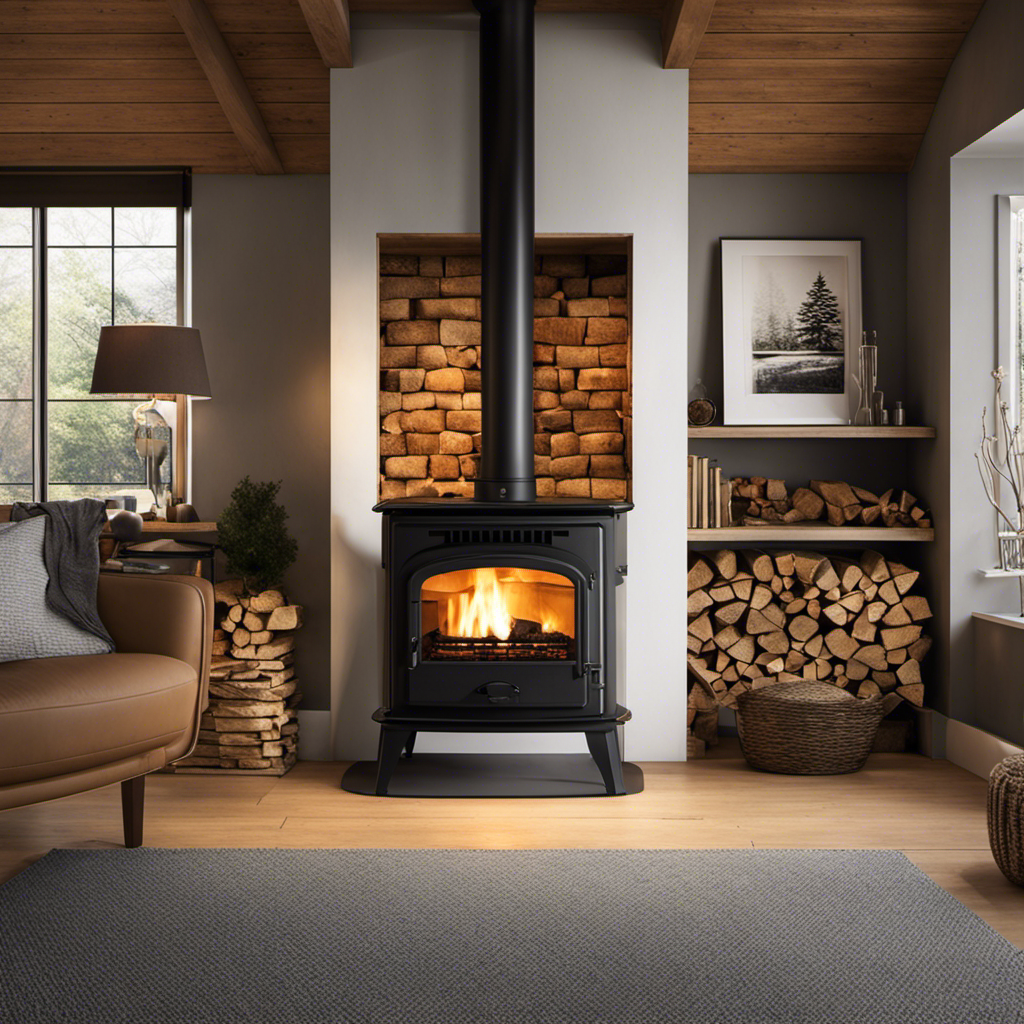
I have been contemplating purchasing a wood pellet stove for my home to effectively warm my small living area, which is under 1000 square feet. However, I am unsure about what size stove would best suit my needs.
In this article, I’ll provide you with all the information you need to calculate the ideal size of a wood pellet stove for a small area. By exploring key factors and sizing guidelines, we’ll make sure you choose the perfect stove for your heating needs.
Key Takeaways
- Wood pellet stoves are energy efficient appliances that burn compressed wood pellets, providing sustainable and renewable heat for small spaces.
- To calculate the ideal size of a wood pellet stove for less than 1000 sq feet, multiply the square footage by the heating factor (ranging from 25 to 35 BTU per square foot) to determine the BTU per hour needed.
- Consider factors such as insulation, climate, and desired temperature when choosing a stove size, and compare different stoves’ heating capacities, efficiency, and heating costs.
- When choosing a wood pellet stove for a small area, assess the heating capacity, measure the available space, consider design and aesthetics, and take into account insulation and other heating sources.
Understanding the Heating Requirements for Small Spaces
If you’re looking to heat less than 1000 sq feet, it’s important to understand the heating requirements for small spaces.
When it comes to heating options, there are several energy efficient appliances to consider. One popular choice is a wood pellet stove. These stoves burn compressed wood pellets, which are a sustainable and renewable source of fuel. They offer efficient heat output and can be controlled easily.
Wood pellet stoves are known for their ability to evenly distribute heat throughout a small space, making them ideal for heating less than 1000 sq feet. However, it’s crucial to calculate the ideal size of the stove to ensure optimal heating. By considering factors such as insulation, climate, and desired temperature, you can determine the perfect size for your space without wasting energy or money.
Calculating the Ideal Size of a Wood Pellet Stove for Less Than 1000 Sq Feet
To properly heat an area under 1000 sq feet, you should calculate the ideal size of a wood pellet stove. The size of the stove you need depends on the efficiency and heating capacity required for your space.
One way to determine the size is by calculating the BTU (British Thermal Unit) per hour needed to heat your area. The formula is simple: multiply the square footage by the heating factor. The heating factor can range from 25 to 35 BTU per square foot, depending on the insulation and climate.
Once you have the BTU per hour, you can compare different stoves and their heating capacities to find the right fit for your needs. By calculating efficiency and comparing heating costs, you can ensure that your wood pellet stove is the perfect size for your small space.
In addition to size, there are key factors to consider when choosing a wood pellet stove for a small area.
Key Factors to Consider When Choosing a Wood Pellet Stove for a Small Area
When choosing a wood pellet stove for your small area, there are key factors you should consider.
First, you need to assess the heating capacity of the stove. Make sure it is suitable for the size of your space, taking into account any insulation or other heating sources.
Next, consider your space constraints. Measure the available area and ensure the stove will fit comfortably without obstructing walkways or furniture placement.
Additionally, think about the overall design and aesthetics of the stove to ensure it complements your space.
Now, let’s explore the BTU output and efficiency ratings for compact wood pellet stoves, as these factors will further inform your decision-making process.
Exploring the BTU Output and Efficiency Ratings for Compact Wood Pellet Stoves
Exploring the BTU output and efficiency ratings can help inform your decision when choosing a compact wood pellet stove for a small area. Evaluating the cost effectiveness of wood pellet stoves for small spaces and comparing their performance with other heating options for compact areas is crucial. Here are four key points to consider:
-
BTU Output: Look for a stove with an appropriate BTU output for your space. A higher BTU output means more heat generated, but it also consumes more pellets.
-
Efficiency Ratings: Consider the stove’s efficiency rating, which indicates how effectively it converts pellets into heat. Higher efficiency means less waste and lower fuel costs.
-
Cost Effectiveness: Calculate the cost of pellets and compare it to other fuel sources to determine the long-term cost effectiveness of a wood pellet stove.
-
Performance Comparison: Compare the performance of wood pellet stoves with other heating options like electric or propane heaters, considering factors such as ease of use, heat distribution, and environmental impact.
Understanding these factors will help you make an informed decision about the best wood pellet stove for your small space.
Now, let’s move on to sizing guidelines for selecting the perfect wood pellet stove for heating a small space.
Sizing Guidelines for Selecting the Perfect Wood Pellet Stove for Heating a Small Space
Determining the appropriate size of a wood pellet stove for a small area can ensure efficient heating without wasting energy.
When it comes to sizing considerations, there are a few factors to keep in mind. First, you need to calculate the square footage of the space you want to heat. For areas under 1000 square feet, a stove with a heating capacity of 25,000 to 35,000 BTUs should suffice.
Additionally, consider the insulation and layout of the room, as these can affect heat distribution.
As for installation options, wood pellet stoves can be freestanding or insert models. Freestanding stoves offer flexibility in terms of placement, while insert models can fit into existing fireplaces.
Remember to consult with a professional to ensure proper sizing and installation for your specific needs.
Can the Size of the Wood Pellet Stove Affect its Efficiency in Burning Pellets?
The size of the wood pellet stove can impact its efficiency in burning pellets. When troubleshooting wood pellet stove burning, consider how the stove’s size affects heat output and fuel consumption. A properly sized stove will burn pellets efficiently, providing optimal heat and minimizing wasted fuel.
What Size Wood Pellet Stove Do I Need if I Can’t Burn Wood in It?
When choosing a wood pellet stove for a location where burning wood in a pellet stove is prohibited, consider a size that fits the space and meets your heating needs. Look for a model with a high efficiency rating to maximize heat output while complying with regulations.
Frequently Asked Questions
Are Wood Pellet Stoves Safe to Use in Small Spaces?
Wood pellet stoves are safe to use in small spaces. They provide efficient heat and can be cost-effective. However, when determining the appropriate size, consider the square footage, insulation, and climate to ensure optimal heating.
Can Wood Pellet Stoves Be Used as the Primary Heating Source for a Small Area?
Can wood pellet stoves save money on heating bills? How do they compare to other heating options in terms of efficiency? As the primary heating source for a small area, wood pellet stoves are efficient and cost-effective.
Do Wood Pellet Stoves Require a Chimney or Venting System?
Wood pellet stoves typically require a chimney or venting system for proper operation. However, there are ventless options available that can be used as alternative heating methods for spaces less than 1000 sq feet.
How Often Do Wood Pellet Stoves Need to Be Cleaned and Maintained?
When it comes to cleaning and maintaining wood pellet stoves, it’s important to consider the frequency and procedures. Regular cleaning helps ensure optimal performance and extends the lifespan of the stove.
Are There Any Environmental Benefits to Using a Wood Pellet Stove in a Small Space?
There are environmental benefits to using a wood pellet stove in a small space. Compared to traditional heating methods, pellet stoves produce fewer emissions and have a lower carbon footprint. Additionally, the cost of wood pellets is often lower than other fuel sources.
Conclusion
In conclusion, when choosing a wood pellet stove for heating a small space of less than 1000 square feet, it is important to consider the heating requirements, calculate the ideal size, and take into account factors such as BTU output and efficiency ratings.
According to a study conducted by the U.S. Department of Energy, wood pellet stoves can be up to 90% efficient, meaning they effectively convert fuel into heat. This statistic highlights the energy-saving potential of wood pellet stoves, making them a smart choice for efficient and cost-effective heating in small areas.
Logan’s affair with adventure began in childhood. He hailed from a small town where vast forests bordered one side and endless shores stretched on the other. His days were spent exploring uncharted woods, climbing tall trees, or listening to the tales of old sailors. This early immersion in a world brimming with stories and mysteries became the foundation of his passion for writing.
-

 Wood Stove3 months ago
Wood Stove3 months agoHow To Build A Thermoelectric Generator For A Wood Stove
-
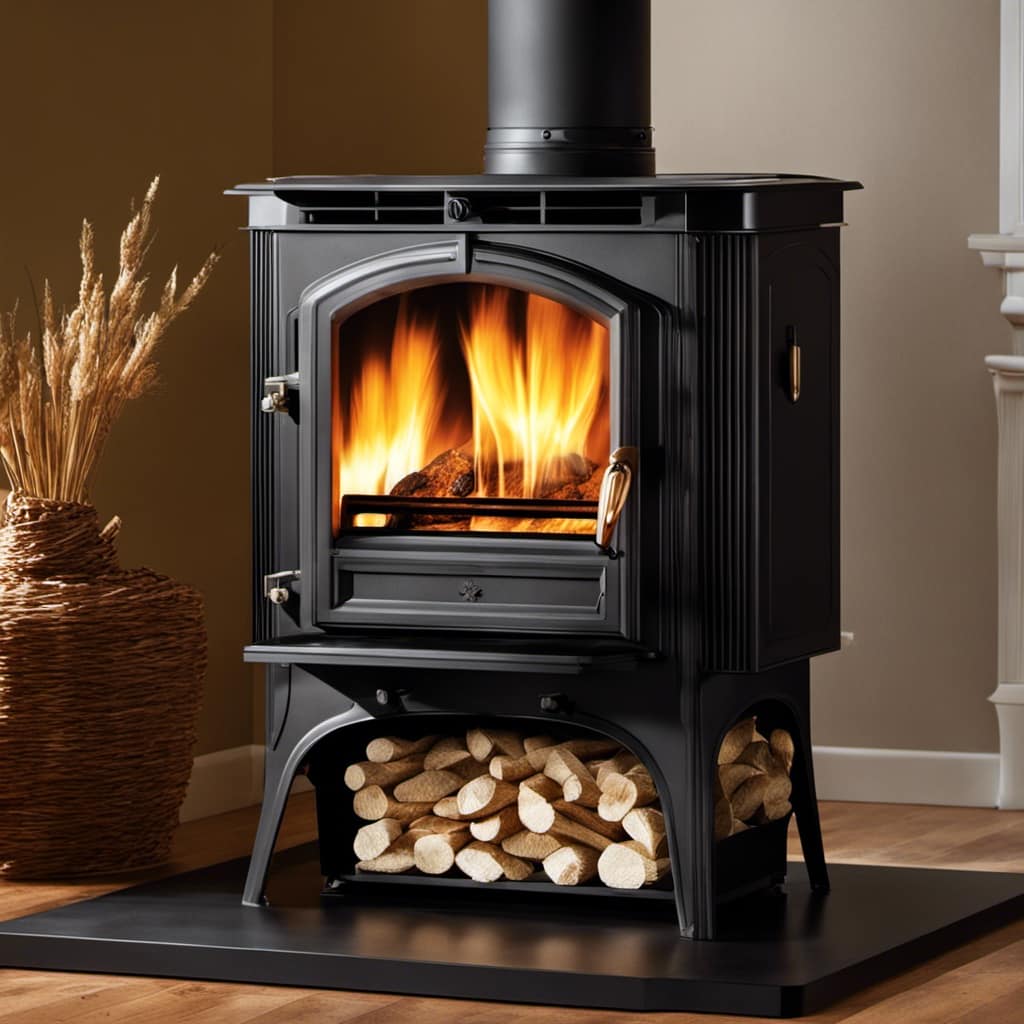
 Wood Stove4 months ago
Wood Stove4 months agoHow To Use Damper And Draft On Wood Stove
-

 Wood Stove4 months ago
Wood Stove4 months agoWhen To Open And Close Damper On Wood Stove
-

 Wood Stove3 months ago
Wood Stove3 months agoHow Far Does Wood Stove Have To Be From Wall
-

 Wood Stove3 months ago
Wood Stove3 months agoHow Does A Circulator Wood Stove Work
-
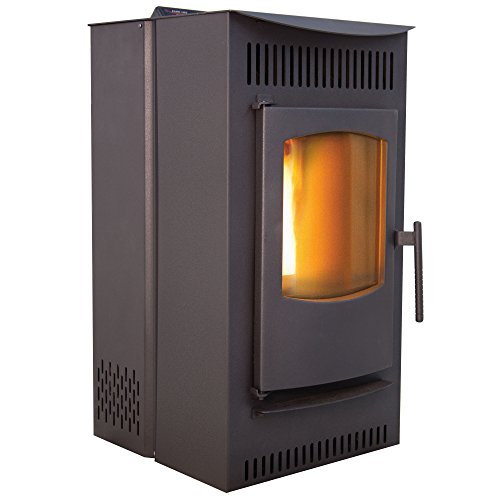
 Pellet Stoves3 months ago
Pellet Stoves3 months agoWhy Is My Wood Pellet Stove Putting so Much Soot
-
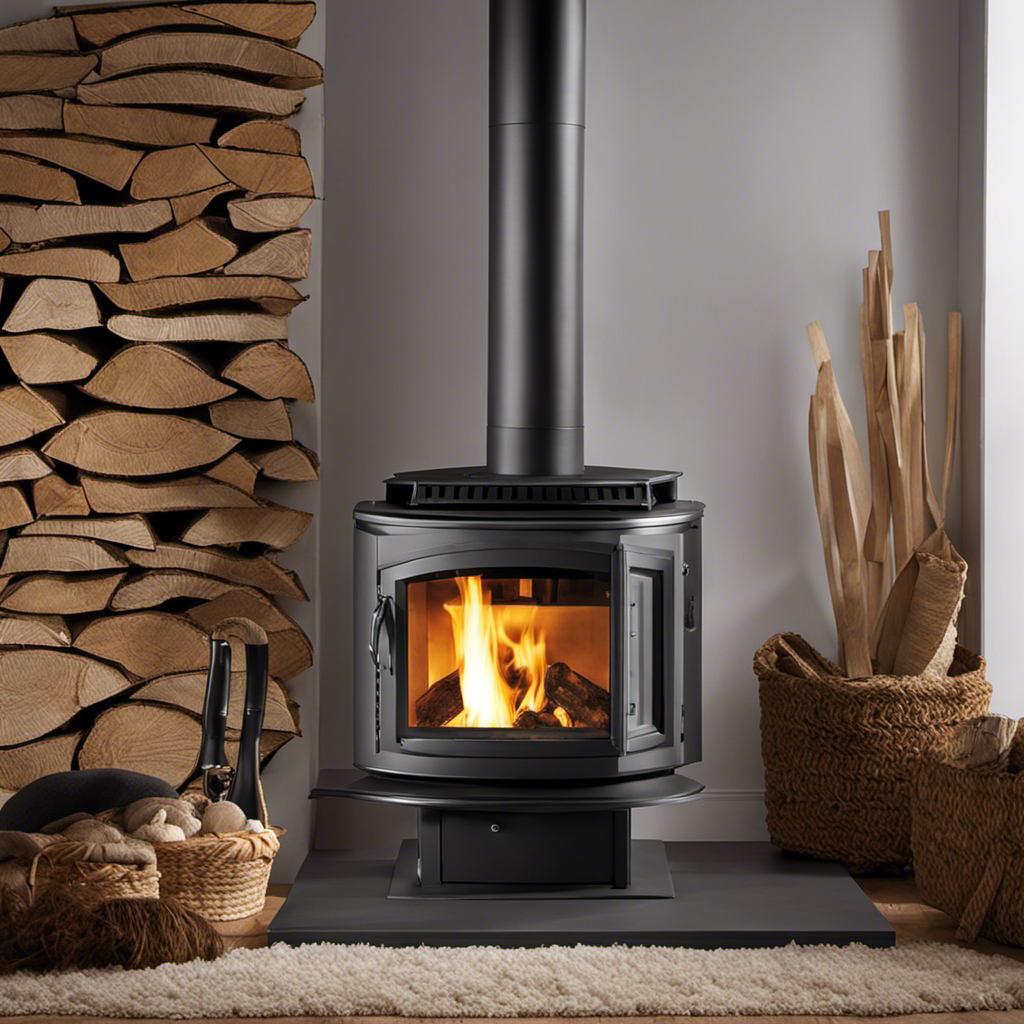
 Wood Stove4 months ago
Wood Stove4 months agoWhat Can I Use As Insulation On Wood Stove Pipes
-
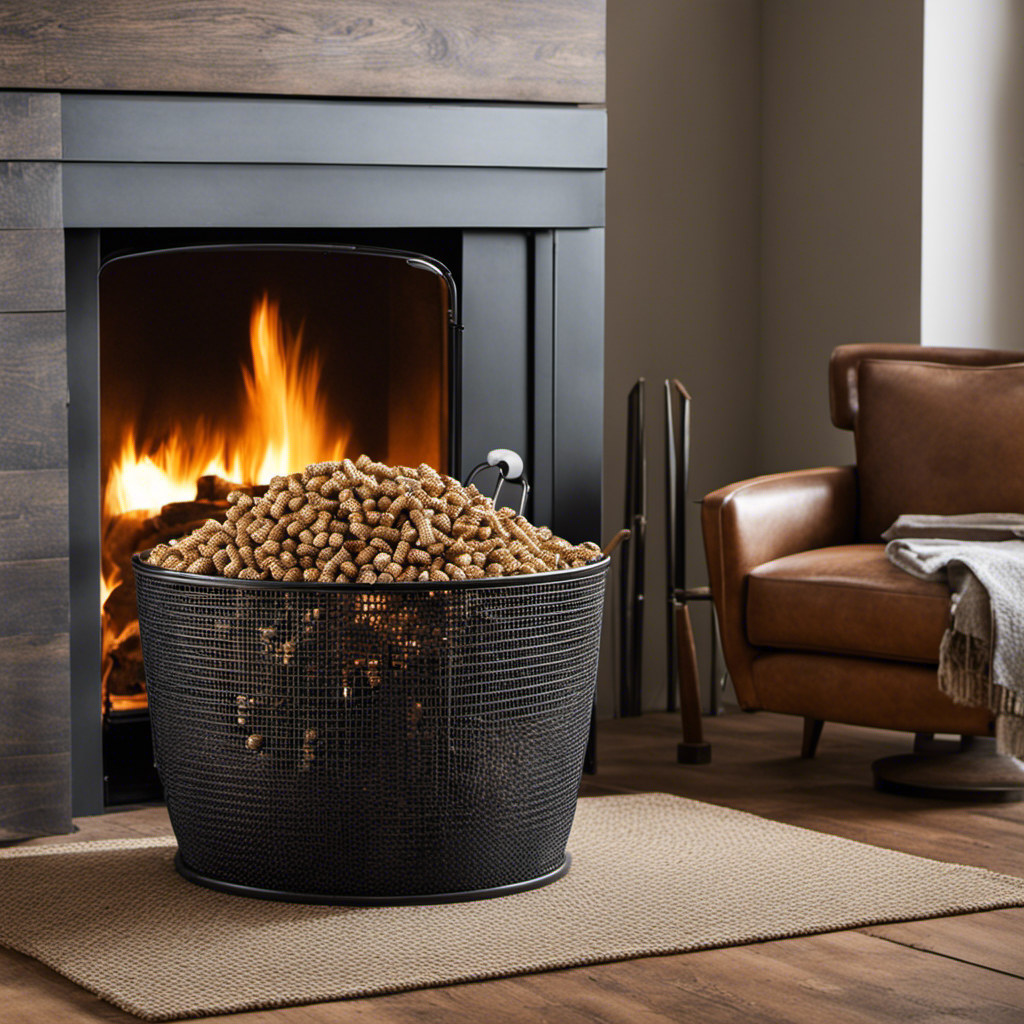
 Pellet Stoves3 months ago
Pellet Stoves3 months agoHow to Make a Pellet Basket for Wood Burning Stoves








